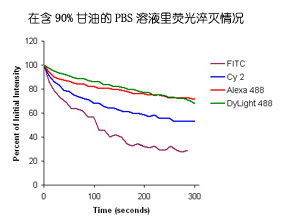FITC fluorescent secondary antibody? ——EarthOx new DyLight 488 green fluorescence
FITC (Fluorescein Isothiocyanate, fluorescein isothiocyanate) is a green fluorophore that is often used in immunological experiments to label fluorophores to corresponding detection molecules, such as antibodies. The pure product of FITC is yellow or orange-yellow crystalline powder, easily soluble in water and alcoholic solvents. The FITC molecular weight is 389.4, the maximum absorption wavelength is 490-495nm, and the maximum emission wavelength is 520-530nm, showing bright yellow-green fluorescence. FITC can be stored in a cold, dark and dry place for many years, and it is currently the most widely used fluorescein. Since FITC is a small molecule compound, each antibody can label several FITC molecules. IgM is usually labeled with small molecule fluorescein, such as FITC, Cy3 / 5, Texas Red, etc.
We know that the green fluorescence intensity of FITC is very bright when visually observed, but it can be seen from the above figure that it is still weak compared to Cy2, and DyLight 488 is even better. DyLight is a new type of fluorescent molecule. Compared with traditional fluorophores such as FITC, Rhodamine, Texas Red, etc., it has stronger fluorescence intensity, higher optical stability and specificity. At the same time, DyLight is complete, such as Dylight 405 is blue fluorescence, Dylight 488 is green fluorescence, can completely replace FITC; completely replace Cy3 and Rhodamin Dylight 549; replace Texas Red Dylight 594; Dylight 633 and Dylight 649 are stronger Red fluorescence; In addition, Dylight also has near-infrared and far-infrared secondary antibodies adapted to the Odyssey system, Dylight 680 and DyLight 800, respectively.

FITC itself is stable in nature and can be combined with proteins. It is the most commonly used fluorescent probe for detecting proteins in tissue cells. It can also label antibodies and can be used for single or multiple staining in immunohistochemistry. The main advantage of FITC fluorescent secondary antibodies is that the human eye is more sensitive to yellow-green, and the green fluorescence in the sliced ​​specimens is usually less than that of red. The disadvantage is that it is easily quenched under light and easily affected by autofluorescence. In fact, the biggest disadvantage of FITC fluorescent secondary antibody is the fast quenching, so it should be used together with anti-quenching agent. DyLight 488 is completely different. As shown in the figure on the right, the fluorescence quenching of different fluorophores in an anti-quenching agent (90% glycerol in PBS) can be seen from the figure. FITC quenches fastest, followed by Cy2, while Dylight 488 and Alexa 488 both have very good light stability. Therefore DyLigt is very suitable for fluorescent photography. So what kind of fluorophore is Dylight? Regardless of structure, function and application, Dylight is a new fluorophore. Compared with traditional fluorophores, its molecular weight is relatively small, so a large molecule can be labeled with more Dylight, while a single Dylight fluorescence Group, its fluorescence intensity is stronger, and its specificity is better; Dylight is more stable to light, which means that it has higher quenching resistance, unlike FITC, which cannot capture fluorescent images in time because of rapid quenching.
One issue that may need to be considered is the price. In fact, Dylight ’s fluorescent secondary antibodies have a higher cost performance than conventional fluorescent secondary antibodies. Generally speaking, the price of Dylight is only about 20% higher than conventional secondary antibodies, but The potency of Dylight is usually about 2-4 times that of conventional fluorescent secondary antibodies, so Dylight is superior in terms of the final cost performance. For example, the EarthOx FITC-labeled goat anti-mouse IgG secondary antibody (Cat. No. E031210), 100μl and 500μl are priced at ¥ 160 and ¥ 640, respectively; and the corresponding EarthOx Dylight 488 labeled goat anti-mouse IgG secondary antibody (The article number is E032210), 100μl and 500μl are quoted at 200 and 800 respectively, but in specific use, such as immunofluorescence experiments, the recommended dilution ratio is 1: 100 and 1: 400, that is, 100μl and 500μl FITC label Goat anti-mouse IgG secondary antibody (Cat. No. E031210) final use solution is 10ml and 50ml, and 100μl and 500μl Dylight 488 labeled goat anti-mouse IgG secondary antibody (Cat. No. E032210) final use solution is 40ml and 200ml, visible, Even without considering Dylight's higher fluorescence intensity, better optical stability and specificity, in terms of price, Dylight fluorescent secondary antibodies also have a higher cost performance. The following picture shows the original DyLight 488 imported from EarthOx. For the secondary antibody products of different species, Emmett provides spot packaging:
Chinese and English Brand Name Part Number Specification Details DyLight 488 AffiniPure Goat Anti-Mouse IgG (H + L) EarthOx E032210 ¥ 200 / 100μl ¥ 800 / 500μl Details DyLight 488 AffiniPure Goat Anti-Rabbit IgG (H + L) EarthOx E032220 ¥ 200 / 100μl ¥ 800 / 500μl details DyLight 488 AffiniPure Rabbit Anti-Goat IgG (H + L) EarthOx E032230 ¥ 200 / 100μl ¥ 800 / 500μl details DyLight 488 AffiniPure Goat Anti-Rat IgG (H + L) EarthOx E032240 ¥ 200 / 100μl ¥ 800 / 500μl DetailsZENGHUI PAPER PACKAGE is a good Food Packaging manufacturers and suppliers with good reputation, we have our own food packaging box factory, we are able to provide our customers varieties of candy boxes with good quality and reasonable price. such as wedding candy boxes,children candy boxes etc.Welcome to wholesale products from us.
Candy Storage Boxes,Candy Paper Storage Boxes,Candy Storage Box,Candy Package Box
Zenghui Paper Package Industry and Trading Company , https://www.packagebox.nl